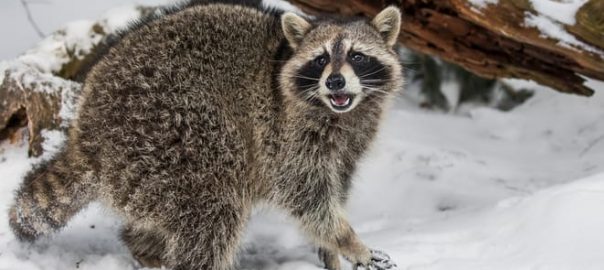What Do Raccoons Eat in the Wild?

Raccoons that live in the wild tend to settle down in forests as near as they can get to a body of water. However, some wild raccoons also live in rural and urban areas. Housing and business development destroy forestry, and so the raccoon must adapt to a new environment. So, what does a raccoon eat in the wild, whether living in the forest or among rural and urban living conditions?
Forest Food
Raccoons are scavengers, so they will eat nearly anything. If they manage to live undisturbed in the forest, they will seek out some of their favourite dietary preferences. Raccoons that live in the forest have a fondness for foods that come fresh from the water, which includes snails, frogs, fish, clams, and crayfish.
When living in the forest, raccoons will also seek out additional food options, such as slugs, insects, bird eggs, and even birds. They also really like vegetables, fruits, seeds, and nuts. If necessary, a raccoon will sustain itself by eating dead animals.
Rural and Urban Food
When a raccoon must live in rural and urban settings, their wild food diet will shift. Instead, they will end up seeking out food left in garbage bins or they will much on pet food left for outdoor pets. Although they are not great at hunting, the raccoon will also make an attempt to catch and eat mice, rats, and squirrels.
Method of Survival
Although foods scavenged from trash bins does not provide a balanced diet like that of raccoons living in the forest, it is enough to help them survive. Raccoons will eat nearly anything to ensure their survival.
Raccoons in the wild tend to live approximately two to three years, yet captive raccoons can live up to thirteen years. Typically, adult raccoons do not die of starvation because they are such great scavengers. Instead, it is human and predator activity that shortens their lifespan in the wild.
Raccoons are often targets for hunters and trappers. They also die getting hit by a vehicle while crossing the road. They may also suffer from diseases introduced either naturally or by human encounters. Certain predators can also pose a threat, such as cougars, coyotes, and domesticated dogs.
When it comes to starvation, young raccoons are far more susceptible because they are not old enough to have a well-developed layer of fat. Adult raccoons with a developed layer of fat can draw from their fat reserves when scavenging for food proves difficult.
A Word of Advice
If you see a raccoon, whether in the wilds of the forest or in your rural or urban neighbourhood, do not attempt to feed it. They are good scavengers for a reason. Raccoons carry diseases that are harmful to humans, so it is best to avoid a raccoon at all costs. If you stay out of their way, they will move along and not bother you.
If, however, you notice one living on your property or even nesting up in your attic, you should call a pest control company immediately. Do not attempt DIY raccoon removal. Raccoons and other wildlife are under the protection of Canadian wildlife that prohibits cruel and unusual methods of removal. A professional raccoon removal knows best how to handle proper methods of raccoon removal.